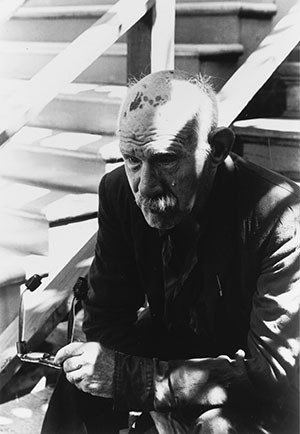Born 1892, died 1973, Chicago, Illinois
“Unlike most children, I hated to see the day come when I will be grown up . . . I wished to be young always,” Henry Darger declared in his autobiography.[1] Inspired by L. Frank Baum’s Oz series and Harriet Beecher Stowe’s Uncle Tom’s Cabin, Darger wrote and illustrated a fifteen-volume book in which children figure prominently. Titled The Story of the Vivian Girls, in What Is Known as the Realms of the Unreal, of the Glandeco-Angelinian War Storm, Caused by the Child Slave Rebellion, Darger’s tale follows the seven young Vivian princesses of the Catholic nation of Abbieannia as they fight a war to end child slavery in the evil empire of Glandelinia.
Darger’s graphic depiction of children being strangled, disemboweled, and crucified has prompted speculation about his mental health. His own childhood was certainly marked by trauma. He was orphaned, separated from his younger sister, and taken as a ward of a Catholic boys home where he was diagnosed as “feeble-minded” and committed to an asylum in Lincoln, Illinois. After several failed attempts, Darger ultimately escaped the asylum at age seventeen and returned to Chicago, where he found work as a janitor in Catholic hospitals. Though his early experiences may have guided his novel’s focus on the victimization of children, the influence of current world events and his devout Catholicism are also palpable. Begun around 1912 and continued through World Wars I and II, Darger’s Realms of the Unreal incorporates war photography and newspaper coverage of battles. And as Michael Moon has observed, the gruesome scenes resemble Catholic martyrdom imagery.
Just as Darger’s writing was a pastiche of popular fiction, Christian mythology, and newspaper reportage, so his illustrations were appropriated from storybooks, advertisements, and comics, which he traced and reassembled into his own compositions. Darger sometimes had such images photographically enlarged at the drugstore so that he could control the scale of figures and create works up to twelve feet wide. His landlord, Nathan Lerner, discovered Darger’s panoramic watercolors and the 15,000-page text they illustrate after the artist moved to a retirement home in 1972. Lerner, an artist himself, shared Darger’s opus with curators, leading to his first exhibition at the Hyde Park Art Center in 1977.
Antonia Pocock
[1] Reproduced in Biesenbach 2009, 283.
Biesenbach, Klaus. Henry Darger. New York: American Folk Art Museum, with Prestel, Munich and New York, 2009.
Moon, Michael. Darger’s Resources. Durham and London: Duke University Press, 2012.
